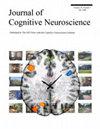Spatial Predictive Context Speeds Up Visual Search by Biasing Local Attentional Competition
IF 3.1
3区 医学
Q2 NEUROSCIENCES
引用次数: 0
Abstract
The human visual system is equipped to rapidly and implicitly learn and exploit the statistical regularities in our environment. Within visual search, contextual cueing demonstrates how implicit knowledge of scenes can improve search performance. This is commonly interpreted as spatial context in the scenes becoming predictive of the target location, which leads to a more efficient guidance of attention during search. However, what drives this enhanced guidance is unknown. First, it is under debate whether the entire scene (global context) or more local context drives this phenomenon. Second, it is unclear how exactly improved attentional guidance is enabled by target enhancement and distractor suppression. In the present magnetoencephalography experiment, we leveraged rapid invisible frequency tagging to answer these two outstanding questions. We found that the improved performance when searching implicitly familiar scenes was accompanied by a stronger neural representation of the target stimulus, at the cost specifically of those distractors directly surrounding the target. Crucially, this biasing of local attentional competition was behaviorally relevant when searching familiar scenes. Taken together, we conclude that implicitly learned spatial predictive context improves how we search our environment by sharpening the attentional field.空间预测语境通过偏移局部注意力竞争加速视觉搜索
人类的视觉系统能够快速、隐性地学习和利用环境中的统计规律。在视觉搜索中,情境提示展示了场景的隐性知识如何提高搜索性能。这通常被解释为场景中的空间上下文可以预测目标位置,从而在搜索过程中更有效地引导注意力。然而,是什么驱动了这种增强的引导作用尚不清楚。首先,是整个场景(全局语境)还是更多的局部语境驱动了这一现象,目前还存在争议。其次,目前还不清楚目标增强和分心物抑制究竟是如何改善注意力引导的。在本脑磁图实验中,我们利用快速隐形频率标记来回答这两个悬而未决的问题。我们发现,在搜索隐含熟悉场景时,目标刺激的神经表征会更强,而直接围绕目标的那些分心物的神经表征则会明显降低,从而提高了注意力。最重要的是,这种局部注意竞争的偏差在搜索熟悉场景时具有行为相关性。综上所述,我们得出的结论是,内隐学习的空间预测情境可以通过锐化注意场来改善我们搜索环境的方式。
本文章由计算机程序翻译,如有差异,请以英文原文为准。
求助全文
约1分钟内获得全文
求助全文
来源期刊
CiteScore
5.30
自引率
3.10%
发文量
151
审稿时长
3-8 weeks
期刊介绍:
Journal of Cognitive Neuroscience investigates brain–behavior interaction and promotes lively interchange among the mind sciences.

 求助内容:
求助内容: 应助结果提醒方式:
应助结果提醒方式:


